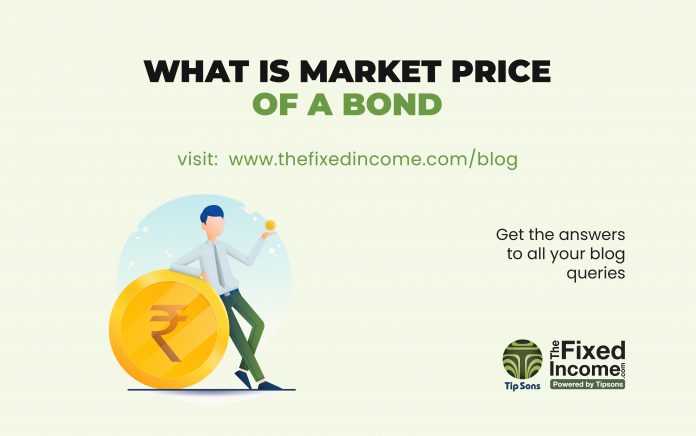In a bond world, it is important to understand the three key metrics: Market Price, YTM, and Coupon Rate, and the relation between them three. We discussed YTM and its Inverse Relation with Market Price in the previous blog, now let’s take a closer look at what the market price of a bond is and its relation with the coupon rate.


MARKET PRICE OF A BOND
Market price is the sum of present value of all future cash flows of the bond. In other words, the market price reflects the current value of the income an investor generates from regular coupon payments (interest income), plus the value of the principal amount which will be redeemed to the investor on maturity. The rate used to discount the future cash flows to the present value is YTM rate.


Exponential values are calculated using an exponential calculator
Example 1:
Market price of a bond with a face value of ₹100, YTM of 6.085%, annual coupon rate of 7.5% paid semi-annually, term to maturity of 9 years, will be ₹110


MARKET PRICE TERMINOLOGY
In the context of a market price, we often hear terms like ‘par’, ‘discount’, and ‘premium’. What that means is whether a bond is trading at par, or at a discount, or at a premium.
Par bond: a bond in the primary market with issue price as the face value, is said to be trading at ‘par’.
Discounted bond: when the coupon rate is lower than YTM, a bond is said to be trading at a ‘discount’ in the secondary market. A discounted bond will have its price lower than its face value. Buying a discounted bond will result in a capital gain.
Premium bond: when the coupon rate is higher than YTM, a bond is said to be trading at a ‘premium’, in the secondary market. A premium bond will have its price higher than its face value. Buying a premium bond will result in a capital loss.
RELATION BETWEEN MARKET PRICE AND COUPON RATE
YTM, market price, and the coupon rate of a bond are all either inversely or directly related. Underlying driver for a movement in these three key metrics is the market interest rate, also referred to as ‘interest rate’ in this blog. Do note that the interest rates, as part of the monetary policy, are not the only driving factor causing a movement in bond metrics. There are other factors to be considered too including the demand and supply of a bond, and the credit rating of a bond issuer.
The market price of a bond is inversely related to coupon rate, which is pegged to the prevailing interest rate. In other words, an increase in the interest rate will drive the market price of a bond down, and vice-versa.
As we know now, the market price of a bond is the current value of the regular coupon payments plus the principal amount. When the interest rates rise or fall, the value of the bond relating to the regular coupon payments will rise or fall too. However, existing bonds will still be paying a higher coupon payment (which was based on the prevailing interest rates at the time of issuing those bonds).
When the interest rates fall and are lower than the coupon rate of an existing bond, a bond issuer will have to offer a lower coupon rate on the newly issued bonds than what was on the existing bonds. As a result, an investor will now earn a lower interest income (coupon payment) on these newly issued bonds than the interest income they were generating from the existing bond. This will make the existing bonds attractive for investing, increasing the demand for them in the market, and increasing the market price of these existing bonds. Such bonds are said to be trading at a ‘premium’.
On the other hand, when the interest rates rise and are higher than the coupon rate of an existing bond, a bond issuer will now offer a higher coupon rate on the newly issued bonds than what was on the existing bonds. As a result, an investor will now earn a higher interest income (coupon payment) on these newly issued bonds as opposed to what they must be earning from the existing bonds. This will make the existing bonds less attractive for investing, reducing their demand in the market, and declining the market price of these existing bonds. Such bonds are said to be trading at a ‘discount’.
Decrease in the market price of the existing bonds is driven by the reluctance of investors to invest in lower coupon bonds when they have an option to earn higher coupon payments from the newly issued bonds.
As you would note, market price plays a key role in the secondary market transactions and one must understand what drives the movement in the market price. Hope the above makes it clear to our readers.
Happy investing!






















